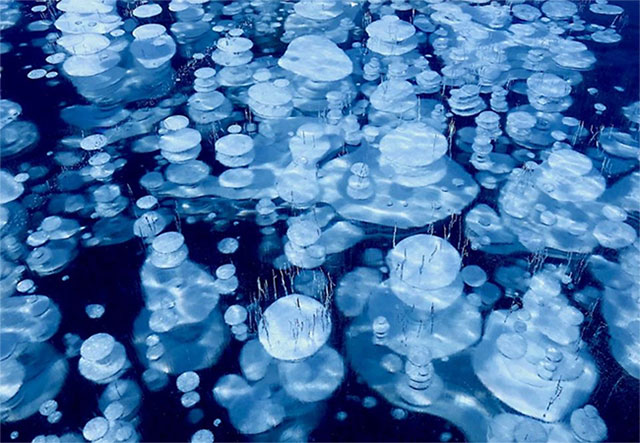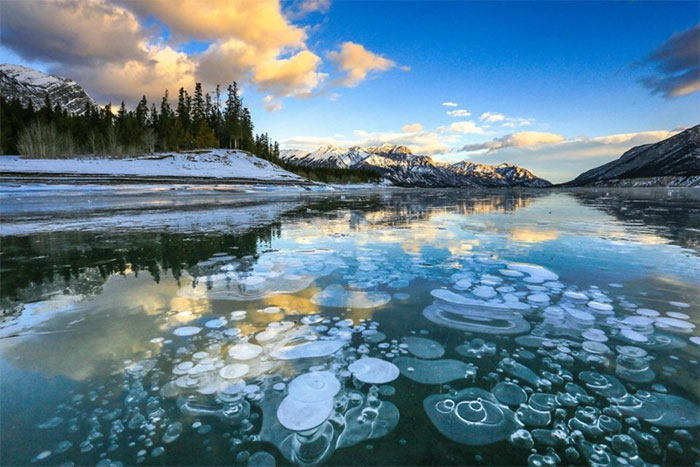The mystery of 'frozen' bubbles at Lake Abraham
Amid the rugged peaks of the Rocky Mountains in Alberta, Canada, a mesmerizing natural spectacle emerges each winter at Abraham Lake, transforming its icy expanse into an enchanting picture decorated with decorated with thousands of delicate ice bubbles.

Abraham Lake stretches approximately 33km between the Kootenay Plains and Nordegg, a ghost town located in Alberta's Bighorn countryside. In winter, the only way to this man-made lake is via the David Thompson Highway - a road perhaps named after the intrepid explorer who mapped most of Western Canada.
Nestled amidst the snow-covered landscape of the Rocky Mountains in Alberta is Abraham Lake , a reservoir famous for its unique and mesmerizing phenomenon - frozen bubbles . When winter falls, the lake transforms into a captivating canvas, decorated with thousands of tiny white bubbles trapped in the crystalline ice.
The origin of these ice bubbles can be traced to the bottom of the lake , where decomposing organic matter, mainly plants and twigs, as well as animal carcasses, release methane. As the water temperature drops, methane gas, which is lighter than water, rises to the surface, forming a network of bubbles encased in solidified ice and creating a surreal spectacle of white orbs and patterns .

During the winter months, temperatures around Abraham Lake can drop to extremely low levels and winds can reach 48km/h. The constantly moving icy wind makes the ice on the lake surface as clear as crystal, opening a window to the surreal beauty hidden below: frozen methane bubbles.
The best time to witness this natural spectacle is from mid-January to early February , when the bubbles are at their highest. The thickness of the ice at this time allows visitors to walk on the lake safely, seeing up close the shimmering bubbles under their feet.
Wind also helps snow move away from the ice, making bubbles more visible. However, you should always be cautious when venturing on ice as ice can vary in thickness and stability depending on location and weather conditions.

Like many other lakes around the world, Abraham Lake emits methane gas year-round. However, in winter, this biological process can create surprising visual phenomena. When bacteria in the lake digest decomposing organic matter, they release large amounts of methane gas into bubbles that float to the surface of the lake.
The frozen bubbles of Lake Abraham are more than just a visual treat; they also play an important role in the lake's ecosystem . Methane trapped in the bubbles serves as a food source for bacteria and other microorganisms, contributing to the biodiversity of the lake.
To experience the frozen bubbles of Abraham Lake, you'll first need to take the only road into Abraham Lake, the David Thompson Highway (H11), then drive to the Preacher Point Observation Platform, located at the far end. south of the lake. From there, you can venture onto the ice, carefully following the designated path and avoiding areas with cracks or thin ice.

When exposed to colder temperatures on the surface of the lake, the bubbles freeze into sparkling pillars and round, milky bubbles. Thanks to the unique transparency of Abraham Lake's ice surface, it has become a popular spot for tourists from all over to take photos of the methane bubbles below. In addition to the beautiful bubble structures of methane gas under the surface of the lake, the icy surface itself, often blown and polished by winter winds, is as beautiful as a work of art.
Places where you can view frozen bubbles include Windy Point and Hoodoo Creek. These locations offer stunning views of the lake and surrounding Rocky Mountains. You can also take a guided tour or rent ice skates and other equipment from local equipment vendors. But be careful not to burst or burn the balloons because they contain flammable gases that can be harmful if inhaled or exposed to fire.

Scott Zolkos, a doctoral student at the University of Alberta, has spent a lot of effort learning about the thawing of permafrost on freshwater - a phenomenon that can lead to increased methane gas levels in the Earth's atmosphere. Although Abraham Lake is not located in a permafrost zone, measuring the amount of methane below the lake's surface could help people understand more about how the lake will affect climate change. For Scott Zolkos, the peaceful landscape around the lake is the perfect setting for his research: "One of the great things about science is that the door is always open for you to find something interesting and unexpected. ".
A visit to Abraham Lake in winter is sure to be an unforgettable experience, offering a glimpse of the wonders of nature and the delicate balance of the environment. Frozen bubbles, like tiny sentinels of the lake ecosystem, remind us of the interconnectedness of life and the beauty that emerges even in the harshest conditions.
- Stand in front of the cold beauty of frozen lakes
- Admire the strange 'jellyfish' phenomenon in Canada
- Video: The beauty of the bubble is frozen
- The bubble froze in the sunlight
- Natron's secret of making the creature turn into a
- Discover the secrets of the world's most salty lake
- April 15: Abraham Lincoln dies after being assassinated and the mystery behind the president
- What are opaque foam that appears in the food pot when cooking?
- Strange zigzag road on Iceland's largest ice lake
- What's so hot in the bubble bubble?
- America: Detecting an odd circle on the ice lake
- Russia successfully approached the most mysterious lake in the world
 The truth about the mysterious red-haired giant at Lovelock Cave
The truth about the mysterious red-haired giant at Lovelock Cave Inunaki Tunnel: The haunted road leading into Japan's 'village of death'
Inunaki Tunnel: The haunted road leading into Japan's 'village of death' The mystery of the phenomenon of human reflection before dying
The mystery of the phenomenon of human reflection before dying 6 mysterious phenomena, although science has been developed for a long time, still cannot be answered
6 mysterious phenomena, although science has been developed for a long time, still cannot be answered